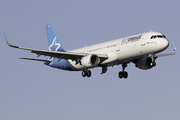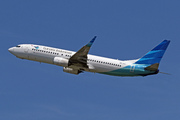Dépêches
Fitch Rates San Francisco Int'l Airport's (California) $175MM Revs 'F1'
Dépèche transmise le 3 août 2009 par Business Wire
NEW YORK--(BUSINESS WIRE)--Fitch Ratings assigns an 'F1' to $175 million Airport Commission, City and County of San Francisco, CA, San Francisco International Airport (SFO), second series revenue refunding bonds, series 2009 consisting of:
--$92,500,000 series 2009A (Non-AMT/Private Activity);
--$82,500,000 series 2009B (Non-AMT/Private Activity).
Fitch affirms its 'F1' rating on $88.2 million in outstanding series 2008B, short term notes. Fitch also affirms its 'A' rating on $3.9 billion in outstanding debt. The Rating Outlook is Positive.
This transaction is the result of management's decision to not move forward with the remarketing of Issue 34A&B that would have completed the conversion to non-alternative minimum tax (AMT) private activity bonds from AMT, as previously analyzed and stated by Fitch in a press release dated on May 21, 2009, 'Fitch affirms $442MM San Francisco (California) Int'l Airport Revs 'A', Positive Outlook'.
The 'F1' short-term rating reflects SFO's solid cash position totaling $404 million when including the airports contingency account, commercial paper capacity, and unrestricted cash as of June 30, 2009. The rating is also based on a revenue pledge which is on parity with the outstanding airport second series revenue bond debt. In addition, management has the necessary authorizations in place to allow for the issuance of refunding bonds and has exhibited the ability to execute a long-term financial strategy to ensure the airport meets its obligations prior to the mandatory redemption for the 2009 bonds in 2010.
The series 2009A&B revenue bonds are one-year bonds with a mandatory redemption date set for Sept. 3, 2010. Proceeds of the 2009 revenue bonds will be used to purchase and hold in trust all of the $175 million in outstanding Issue 34A&B bonds. The trust will be under the control of SFO and provides some near term protections to volatile interest rate weekly resets, as experienced immediately after the downgrade of the bond's liquidity provider. By establishing the trust the associated standby bond purchase agreement and bond insurance policy will remain in place. The amortization schedule on the Issue 34A&B bonds will remain the same while in the trust. Airport management maintains the option to either cancel the Issue 34A&B trust bonds or to remarket the trust bonds out of the trust account to investors in a new interest rate mode. In the event there is a failed remarketing, the Issue 34A&B trust bonds have additional liquidity support provided by the standby bond purchase agreement that expires in 2013.
As both trustor and beneficiary of the trust, the airport is held neutral with regard to the trust itself, but is exposed to the risk associated with the payment or refinance of the entire $175 million in outstanding 2009A&B bonds, structured as a bullet maturity on Sept. 3, 2010. This exposure is mitigated to some degree by the standby bond purchase agreement and the ability to remarket the bonds. Nonetheless, this issuance increases the airports exposure to mandatory tenders over the next several years with a total of $88.2 million due later in 2009, $275 million in 2010, $100 million in 2011 and $26.7 million in 2012. Of the upcoming $490 million airport revenue bonds and notes that are subject to staggered mandatory tender dates (including the 2009A&B bonds) through 2012, 36% have external liquidity support.
Airport management is currently evaluating the costs and benefits for a potential issuance of roll-over notes, fixed-rate debt, or a remarketing the bonds out of the trust accounts to address the refinance risk. A failure to structure a take-out financing for either the 2008A&B notes or the 2009A&B bonds could result in a weakened balance sheet and a higher cost structure for the airlines placing pressure on the airport's long-term underlying rating.
Management has reduced its exposure to variable-rate debt to approximately 15% of the airport's $3.9 billion outstanding debt, down from 20% in the early part of 2008. Approximately 9% is synthetically fixed. The interest rate and term-out risk for the variable-rate debt is relatively low given the airport's sufficient available resources to accommodate any increased principal and interest requirements over the near term. In total, the airport has four standby bond purchase agreements and two letters of credit that provide liquidity for Issues 34A&B, Issues 36A-D, and Issues 37A-D. The terms of the various liquidity providers all vary with expiry dates that range from 2009-2015. In general all agreements each have stipulated cure periods, and bank rates that step up over time and eventually become term loans in a bank bond scenario. Fitch fully expects management to address any failures in remarketings prior to the variable rate debt portion impacting the airport's overall financial health.
The Positive Outlook, which was revised from Stable on Jan. 24, 2008, continues to reflect the overall improved financial picture and the positive operating trends experienced at the airport. These trends have continued despite a slowing economy and the reduction of airline capacity across the region and nation. To date, SFO has been a net beneficiary of adjustments made by the airlines at the Oakland International Airport (OAK) and Norman Y. Mineta San Jose International Airport (SJC). Furthermore, management continues to improve airport profitability and better control the airport's cost per enplanement, which is budgeted at $14.79 in fiscal 2010, down from a high of $19.62 in fiscal 2003. The Outlook also incorporates the potential for the addition of approximately $648 million in new debt, which, given interim debt repayment and revenue growth is not expected to substantially change the financial and debt metrics at SFO.
The 'A' rating captures SFO's importance as a regional transportation provider for long-range domestic and international air service, as well as the San Francisco Bay Area's significant population base (in excess of 7 million), high wealth levels and diverse economy, which support the strong passenger demand for service. Additional strengths include SFO's stable and strong balance sheet and healthy financial operating ratios (44% for fiscal 2008). Credit challenges include the weakening economy and airline industry that can pressure airport financial results, SFO's high cost structure and to some extent, air service market share concentration (40.6%, including United Express and Sky West) in United Airlines (long-term Issuer Default Rating 'CCC' by Fitch). This concentration is partially mitigated by the high level of origination & destination (O&D) enplanements, which represents 76% of total volume. Airport revenues derived from United Airlines represented only 22.7% of SFO's total operating revenues.
Fitch's rating definitions and the terms of use of such ratings are available on the agency's public site, 'www.fitchratings.com'. Published ratings, criteria and methodologies are available from this site, at all times. Fitch's code of conduct, confidentiality, conflicts of interest, affiliate firewall, compliance and other relevant policies and procedures are also available from the 'Code of Conduct' section of this site.
- 21:28 Friedrichshafen 2024 : le projet "Fly The North"
- 16:52 Friedrichshafen 2024 : Aura Aero présente pour la première fois ses trois appareils
- 16:25 Friedrichshafen 2024 : Duc Hélices présente son hélice Tiger-3
- 15:33 Friedrichshafen 2024 : Splash-in Aviation expose son Pétrel X
- 07:25 Friedrichshafen 2024 : Robin "toujours présent et pour longtemps"
- 07:11 Friedrichshafen 2024 : Beringer présente au salon
- 07:01Friedrichshafen 2024 : la FFPLUM dément le passage de tous les ULM 3 axes à 600kg
- 06:44 Friedrichshafen 2024 : visite d'un Pilatus PC-12 (photos)
- 17/04 Friedrichshafen 2024 : Cirrus Aircraft présente son SR G7
- 17/04 Friedrichshafen 2024 : Piper présente son M700 Fury
- 17/04 Friedrichshafen 2024 : Junkers dévoile son A50 Heritage
- 17/04 Friedrichshafen 2024 : la société E-Props présente au salon
- 17/04 Le 30e salon de Friedrichshafen a ouvert ses portes
- 15/04 Airbus : commandes et livraisons de mars 2024
- 15/04 easyJet renforce ses dessertes depuis la France vers Budapest
- 15/04 Vueling inaugure sa liaison entre Orly et Heathrow
- 12/04 British Airways ouvre les candidatures pour son programme cadets Speedbird Pilot Academy
- 12/04 Icelandair et Expedia annoncent un nouveau partenariat
- 12/04 Turkish Airlines : résultats 2023
- 12/04 easyJet annonce deux nouvelles lignes depuis Lyon







